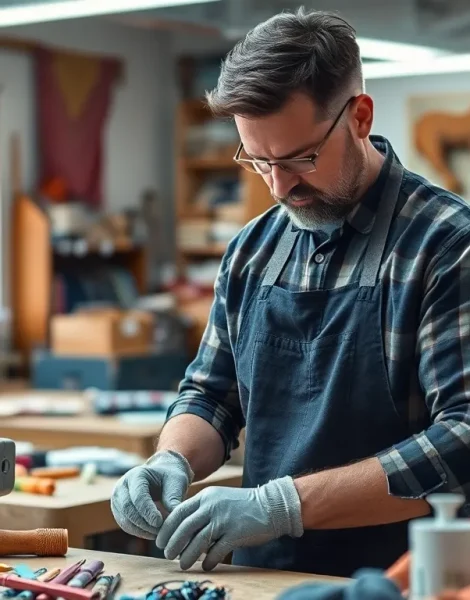In the world of crafting, every project comes with its own set of challenges, and reshaping costs can feel like a sneaky gremlin lurking in the shadows. Just when you think you’ve nailed down your budget, those unexpected expenses pop up like a jack-in-the-box, ready to send your plans spiraling. But fear not! Understanding these costs doesn’t have to be a daunting task; it can actually be quite the adventure.
Table of Contents
ToggleUnderstanding Crafting Reshaping Costs
Crafting reshaping costs refer to the expenses incurred when modifying or adapting materials and designs in crafting projects. These costs arise from material alterations, labor expenses, and potential project delays.
Definition of Crafting Reshaping Costs
Crafting reshaping costs encompass financial implications associated with redesigning or altering crafted items. Costs may arise from reworking existing materials or incorporating new elements into a design. Tailoring projects to meet specific requirements often leads to these adjustments, which can affect overall project pricing. Understanding these costs is crucial for accurate budgeting and project management in crafting.
Importance in Manufacturing
Recognizing crafting reshaping costs is vital for effective manufacturing processes. These costs significantly impact overall production budgets. Overlooking them can lead to unexpected financial strain during projects. Accurate assessment of reshaping costs ensures resource allocation aligns with project goals, minimizes waste, and maximizes efficiency. Additionally, comprehending these costs can enhance strategic planning and improve profit margins. Focusing on reshaping costs enables manufacturers to create better products, ensuring customer satisfaction.
Factors Influencing Crafting Reshaping Costs

Understanding the factors affecting crafting reshaping costs aids in effective project management and budgeting. Key elements include material costs, labor expenses, and equipment maintenance.
Material Costs
Material costs represent a significant portion of reshaping expenses. Pricing fluctuations influence budget predictions. High-quality materials generally lead to higher costs but can improve the final product’s durability and appeal. Local sourcing may reduce transportation expenses and support community businesses. Evaluating the costs of various materials enables better decision-making when selecting components for crafting projects.
Labor Costs
Labor costs encompass wages or fees associated with skilled workers engaging in reshaping tasks. Hourly rates differ based on expertise and location. A well-trained artisan commands higher wages, reflecting their proficiency. Project complexity dictates time requirements, ultimately influencing labor expenses. Effective planning ideally accounts for these costs, ensuring adequate budget provisions for labor throughout the crafting process.
Equipment and Maintenance Costs
Equipment and maintenance costs play a crucial role in overall reshaping costs. Investment in quality tools enhances production efficiency and precision. Regular maintenance minimizes the likelihood of equipment failure, ultimately reducing project delays and unexpected expenses. Tracking maintenance schedules can lead to better asset management. Incorporating these costs into project budgets facilitates informed decisions about purchasing or upgrading necessary tools.
Methods to Optimize Crafting Reshaping Costs
Crafting reshaping costs can be minimized effectively through several strategies.
Lean Manufacturing Techniques
Utilizing lean manufacturing techniques enhances efficiency and reduces costs. Techniques such as value stream mapping help identify waste in processes. Streamlined workflows improve resource allocation and minimize unnecessary expenses. Involving cross-functional teams fosters innovation and leads to better project outcomes. Implementing just-in-time inventory practices reduces storage costs while ensuring materials are available when needed. Overall, adopting lean principles supports a cost-effective approach to managing reshaping projects.
Investment in Technology
Investing in advanced technology pays off by increasing productivity and lowering reshaping costs. Automated tools eliminate repetitive tasks, freeing up skilled labor for more complex activities. Software for project management allows precise tracking of expenses and timelines. Digital design tools also enable quick adjustments, minimizing material waste during crafting. By integrating technology into operations, businesses enhance overall efficiency and adaptability. Upgrading technology can lead to long-term financial savings and improved project outcomes.
Workforce Training and Development
Focusing on workforce training and development significantly enhances skill levels and project efficiency. Training programs ensure workers are adept at utilizing the latest tools and technologies. Mentorship and continuous learning create a workforce that adapts quickly to changes. High levels of employee competency reduce errors and rework, leading to lower reshaping costs. Investing in human capital translates into better project quality and improved overall productivity. Prioritizing training aligns employee skills with project requirements, resulting in a more effective crafting process.
Case Studies on Crafting Reshaping Costs
Examining real-world scenarios highlights best practices and pitfalls in managing crafting reshaping costs. Insights from these case studies enhance understanding of the intricacies involved in budgeting.
Successful Cost Reduction Examples
A furniture manufacturer utilized lean manufacturing to minimize reshaping expenses by 20%. This approach identified waste in the production line, streamlining processes significantly. Another crafting company adopted just-in-time inventory, reducing storage costs and freeing capital. By implementing project management software, a small artisan business tracked expenses in real-time, enabling adjustments that saved 15% in costs. Companies embracing these strategies foster a culture of efficiency, showcasing that innovative practices lead to substantial savings.
Lessons Learned from Failures
One jewelry maker faced unexpected costs after failing to account for material price fluctuations. This oversight led to a 30% budget overrun, emphasizing the need for comprehensive market analysis. An upholstery business encountered labor cost issues due to poor skill alignment in its workforce, escalating project timelines and expenses. Learning from these missteps, companies now prioritize continuous employee training and improved budget forecasting. Adapting strategies based on past failures ensures better management of crafting reshaping costs in future projects.
Understanding crafting reshaping costs is essential for anyone involved in the crafting process. By recognizing the factors that contribute to these expenses and implementing effective strategies, crafters can better manage their budgets and enhance project outcomes. Lean manufacturing techniques and just-in-time inventory practices not only reduce costs but also foster innovation and efficiency.
Investing in employee training and advanced technology ensures that teams are equipped to handle challenges effectively. Learning from both successes and setbacks is crucial for continuous improvement. Embracing these insights leads to more informed decision-making and ultimately strengthens the financial health of crafting projects.









